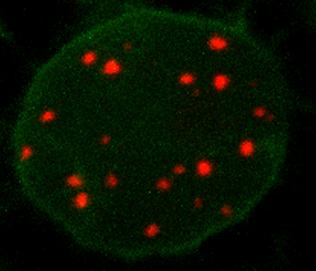Novel application of CRISPR/Cas9 in plants – Visualizing DNA in living cells

Living nucleus of the plant Nicotiana benthamiana shows red fluorescent labelled telomere sequences IPK/Steven Dreissig
The spatial and temporal organization of genomes is important for maintaining and regulating cell functions such as gene expression, DNA replication and repair, and proper segregation of genetic material during cell division. Therefore, elucidating how the genome is spatio-temporally organized inside the nucleus is imperative to understand how genes and non-coding DNA sequences are regulated during development.
Mapping the functional organization of the genome can be achieved by visualizing interactions between different genomic elements in living cells. “While fluorescence-tagged nuclear proteins can be readily imaged in living plant cells, in vivo visualization of defined DNA sequences turned out to be technically difficult”, explains Andreas Houben, head of the research group Chromosome Structure and Function of the IPK.
The discovery of the bacterial originated CRISPR-Cas9 system (type II clustered regularly interspaced short palindromic repeats CRISPR-associated caspase) revolutionized the field of the targeted genome editing in the last five years and has become a routine technology. “By harnessing this system for live cell imaging in plants, our team shows the potential of this technology reaches far beyond the controlled induction of mutations”, explains Steven Dreissig, IPK scientist and first author of the study.
“We demonstrate reliable imaging of telomere repeats located at the ends of the chromosome arms in living cells of Nicotiana benthamiana, a close Australian relative of tobacco, and pave the way for potential visualization of multiple genomic loci.”
“Furthermore, we show that CRISPR-Cas9 can be combined with fluorescence-labelled proteins to investigate DNA-protein interactions in living cells”, adds Holger Puchta, Director of the Botanical Institute in Karlsruhe.
This recent development may potentially enable plant scientists to visualize single genomic loci in living cells. Now the researchers report the outcome of their joint work in The Plant Journal.
Publication: Steven Dreissig, Simon Schiml, Patrick Schindele, Oda Weiss, Twan Rutten, Veit Schubert, Evgeny Gladilin, Michael Florian Mette, Holger Puchta & Andreas Houben (2017): Live cell CRISPR-imaging in plants reveals dynamic telomere movement. The Plant Journal
DOI: dx.doi.org/10.1111/tpj.13601
Media Contact
More Information:
http://www.ipk-gatersleben.deAll latest news from the category: Life Sciences and Chemistry
Articles and reports from the Life Sciences and chemistry area deal with applied and basic research into modern biology, chemistry and human medicine.
Valuable information can be found on a range of life sciences fields including bacteriology, biochemistry, bionics, bioinformatics, biophysics, biotechnology, genetics, geobotany, human biology, marine biology, microbiology, molecular biology, cellular biology, zoology, bioinorganic chemistry, microchemistry and environmental chemistry.
Newest articles

Superradiant atoms could push the boundaries of how precisely time can be measured
Superradiant atoms can help us measure time more precisely than ever. In a new study, researchers from the University of Copenhagen present a new method for measuring the time interval,…

Ion thermoelectric conversion devices for near room temperature
The electrode sheet of the thermoelectric device consists of ionic hydrogel, which is sandwiched between the electrodes to form, and the Prussian blue on the electrode undergoes a redox reaction…

Zap Energy achieves 37-million-degree temperatures in a compact device
New publication reports record electron temperatures for a small-scale, sheared-flow-stabilized Z-pinch fusion device. In the nine decades since humans first produced fusion reactions, only a few fusion technologies have demonstrated…





















